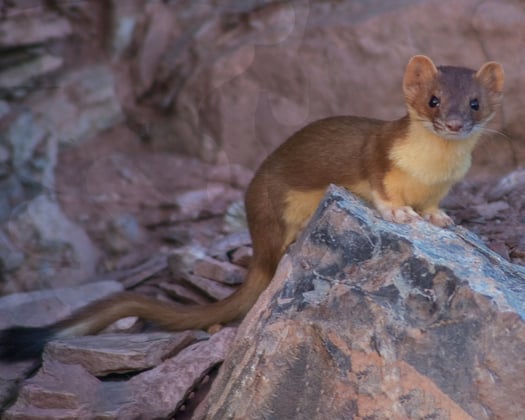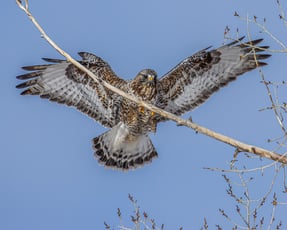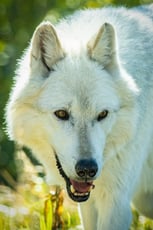Where has all the Wildlife Gone?
This year I have become even more convinced that much of the wildlife in Eagle County and other...


Ecosystems are biological communities which consist of many organisms interacting in a specific physical environment. Humans are often considered the non-native species with the greatest impact on our environment. We make an impact locally, but also globally. Many of those global impacts can be significant locally. What is interesting is that we do not understand many of these interactions. Some are surprising, perhaps unbelievable. What things are we doing that impact the environment in ways we don't know?
Here is an example. Trout found in Yellowstone Lake in Yellowstone National Park caused a decline in the elk herd population surrounding the lake. HUH??
How is that even conceivable? Lake Trout were first found in Yellowstone Lake in 1994. Lake trout are not native to the Yellowstone ecosystem and were probably introduced by anglers that wanted the bigger fish in the lake. Lake trout spawn in the deep areas of the lake, they stay out of the creeks and streams that empty into the lake. One of their favorite foods in the lake is the native cutthroat trout.
Beginning in March, cutthroat trout begin to spawn in the creeks and streams that empty into the lake. Grizzly bears come out of hibernation in April and one of their best sources of protein at that time was the cutthroat. The bears have found fewer cutthroats because of the lake trout predation. That caused the grizzlies to turn to another source of protein, one they could easily catch, elk calves. That is what caused a decline in the elk herd population surrounding the lake!
One person may have a significant impact. The National Park Service believes a human introduced the trout into Yellowstone Lake. That is an incredible example of what many call the "Web of Life." A tug on one strand of the web can impact many other organisms in the web.
Likewise, many people may have a significant impact. Locally, human behavior can have a significant impact on wildlife. We live in an ecosystem which consists of many organisms interacting in a specific physical environment that we as humans have created. It may be good for us but may be bad for bears and other animals. At this time of year there are articles, advertising, and discussions about bears as they enter hyperphagia, which is an extreme need for bears to consume food before hibernation. Bears will often target an easy source which is the trash that humans have not taken care of properly.
An advertising program that headlines “Safe Containers Save Wildlife” is a concise way to remind people that what they do can have an impact on the life of a bear. Hundreds of bears are euthanized in Colorado each year because they became habituated to the trash in communities and became problems or even dangerous. Bears are opportunists, they make the easy choices. We need to eliminate that behavior by eliminating the opportunity for a "free lunch.”
We also impact our ecosystems on a global scale, not just locally. One of the factors we created is climate change. It is more than likely that 2023 will be the hottest year the world has ever seen in historic times. The impact of those high temperatures is significant. Do higher temperatures impact animals like pika, ptarmigan. or long tailed weasels? The answer is that it does.
Ptarmigans are a grouse that live in the alpine environment, the tundra. Climate change is causing spring to come earlier and fall to last later. The ptarmigan is a mottled brown in the summer, but white feathers grow in during the fall and by winter all the summer brown feathers are lost, and the bird is completely white. This change occurs because of the length of daily sunlight, not temperature.
Problem is the snows have not yet covered the tundra. A white bird becomes an obvious target for raptors and carnivores. There is a second problem for ptarmigan. The snow on the tundra now goes through more freeze thaw cycles. The bird burrows into the snow for protection from predators and to escape the brutal winter conditions. They may get frozen under the snow or may not be able to burrow into the snow for their protection.
Long tailed weasels live in forested environments and just like the ptarmigan they are brown in the summer and white in the winter when they also change their name and are called ermine. They can almost disappear in the snow, which makes it easier to hunt prey and avoid predators. The black tip of their tail may have a survival advantage in the winter. When a raptor or predator closes in on the ermine they may go for the black. The talons of raptors or teeth of predators end up with mostly fur and the ermine escapes. When they turn white and are running around on brown grass, they become a bigger target.
As temperatures warm, the American pika, a member of the rabbit family is beginning to have a problem due to rising temperatures. They live in rock piles on the tundra on mountain peaks, areas that stay cool and moist. The pika is well adapted to areas just above freezing. They can overheat and die in mild temperatures above 78 degrees Fahrenheit. As a species they cannot move to higher altitudes because they are already there! According to the National Wildlife Federation 'pikas might be the first species to go extinct due to climate change
14ers.com estimated that 415,000 climbed the 14,000-foot peaks in 2020. That number has declined in recent years. Either way, direct human impact is something we all need to consider. People that climb the peaks and hike any of the trails are likely to leave human waste behind. Many people hike with their dogs. They also leave waste behind. Bacteria in that waste may be harmful to the animals that live in alpine areas. Due to cold temperatures and little soil, it degrades very slowly. This problem is not restricted to 14ers. It is also prevalent at popular backcountry sites, like hot springs, remote lakes, and many 4 x 4 areas.
Waste contains things like E. coli and cryptosporidium. These organisms can sicken wildlife. Dog waste is also high in nitrogen and phosphorus. These act as fertilizers allowing invasive plants to outcompete delicate natives. Dog and human waste can also cause green algae blooms that reduce the oxygen levels in alpine lakes and streams. That may kill fish and beneficial aquatic plants. What can you do? Bag waste in a reusable bag designed to avoid smelly backpacks and carry it out.
We all impact the ecosystems around us. Sometimes we are totally unaware of those impacts.
The Eagle County Community Wildlife Roundtable is a collaborative partnership with the White River National Forest, Colorado Parks and Wildlife, Bureau of Land Management, local government entities, community members, and citizen scientists. The purpose of the Eagle County Community Wildlife Roundtable is to gather a group of diverse stakeholders in the valley to understand and address issues facing wildlife populations. Together we will identify a shared vision and realistic actions that the community can rally around to support wildlife. We want to leverage diverse values, creativity, and resources to move toward positive action.

Rick Spitzer is the author of the article and official photographer for Eagle County Community Wildlife Roundtable.


This year I have become even more convinced that much of the wildlife in Eagle County and other...


Ecologists have long understood food chains. The animal at the top, the prime predator in an...